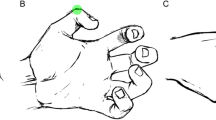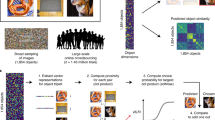Abstract
The cognitive framework of conceptual spaces [3] proposes to represent concepts and properties such as apple and round as convex regions in perception-based similarity spaces.
Access provided by Autonomous University of Puebla. Download conference paper PDF
Similar content being viewed by others
1 Background and Motivation
The cognitive framework of conceptual spaces [3] proposes to represent concepts and properties such as apple and round as convex regions in perception-based similarity spaces. By doing so, the framework can provide a grounding for the nodes of a semantic network. In order to use this framework in practice, one needs to know the structure of the underlying similarity space. In our study, we focus on the domain of shapes. We analyze similarity spaces of varying dimensionality which are based on human similarity ratings and seek to identify directions in these spaces which correspond to shape features from the psychological literature. The analysis scripts used in our study are available at https://github.com/lbechberger/LearningPsychologicalSpaces.
Our psychological account of shapes can provide constraints and inspirations for AI approaches. For example, distances in the shape similarity spaces can give valuable information about visual similarity which can complement other measures of similarity (such as distances in a conceptual graph). Moreover, the interpretable directions in the similarity space provide means for verbalizing this information (e.g., by noting that tools are more elongated than electrical appliances). Furthermore, the shape spaces can be used in bottom-up procedures for constructing new categories, e.g., by applying clustering algorithms. Finally, membership in a category can be determined based on whether or not an item lies inside the convex hull of a given category.
2 Data Collection
We used 60 standardized black-and-white line drawings of common objects (six visually consistent and six visually variable categories with five objects each) for our experiments (see Fig. 1 for an example from each category). We collected 15 shape similarity ratings for all pairwise combinations of the images in a web-based survey with 62 participants. Image pairs were presented one after another on the screen (in random order) and subjects were asked to judge the respective similarity on a Likert scale ranging from 1 (totally dissimilar) to 5 (very similar). The distribution of within-category similarities showed that the internal shape similarity was higher for visually consistent categories (\(M=4.18\)) than for visually variable categories (\(M=2.56\); \(p<.001\)). For further processing, the shape similarity ratings were aggregated into a global matrix of dissimilarities by taking the mean over the individual responses and by inverting the scale (i.e., \(dissimilarity(x,y) = 5 - similarity(x,y)\)).
In the psychological literature, different types of perceptual features are discussed as determining the perception of complex objects, among others the line shape (Lines) and the global shape structure (Form) [1]. We collected values for all images with respect to these two features in two experimental setups.
In a first line of experiments, we collected image-specific ratings which are based on attentive (att) image perception. We collected 9 ratings per image in a web-based survey with 27 participants. Groups of four images were presented one after another on the screen (in random order) together with a continuous scale representing the respective feature (Lines: absolutely straight to strongly curved; Form: elongated to blob-like). Subjects were asked to arrange the images on the respective scale such that the position of each image in the final configuration reflected their value on the respective feature scale. The resulting values were aggregated for each image by using the median.
In a second line of experiments, we collected image-specific feature values which are based on pre-attentive (pre-att) image perception. This was done in two laboratory studies with 18 participants each. In both studies, the images were presented individually for 50 ms on the screen; immediately before and after the image a pattern mask was shown for 50 ms in order to prevent conscious perception of the image. Subjects were asked to decide per button press as fast as possible which value of the respective feature pertained to the critical image mostly (Lines study: straight or curved; Form study: elongated or blob-like). The binary values (in total 18 per image for each feature) were transformed into graded values (percentage of curved and blob-like responses, respectively).
A comparison of the two types of feature values revealed a strong correlation between the judgements based on attentive and pre-attentive shape perception (\(r_s=0.83\) for Lines and \(r_s=0.85\) for Form). In both cases, the 15 images with the highest and lowest values were used as positive and negative examples for the respective feature.
3 Analysis
We used the SMACOF algorithm [4] for performing nonmetric multidimensional scaling (MDS) on the dissimilarity matrix. Given a desired number n of dimensions, MDS represents each stimulus as a point in an n-dimensional space and arranges these points in such a way that their pairwise distances correlate well with the pairwise dissimilarities of the stimuli they represent. The SMACOF algorithm uses an iterative process of matrix multiplications to minimize the remaining difference between distances and dissimilarities.
A good similarity space should be able to reflect the psychological dissimilarities accurately. Figure 2a shows the Spearman correlation of dissimilarities and distances as a function of the number of dimensions. As we can see, a one-dimensional space is not sufficient for an accurate representation of the dissimilarities. We can furthermore observe that using more than five dimensions does not considerably improve the correlation to the dissimilarities. As a baseline, we have also computed the distances between the pixels of various downscaled versions of the images. These pixel-based distances reached only a Spearman correlation of \(r_s = 0.40\) to the dissimilarities, indicating that shape similarity cannot easily be determined based on raw pixel information.
The framework of conceptual spaces assumes that the similarity spaces are based on interpretable dimensions. As distances between points are invariant under rotations, the axes of the coordinate system from the MDS solution might however not coincide with interpretable features. In order to identify interpretable directions in the similarity spaces, we trained a linear support vector machine to separate positive from negative examples for each of the psychological features. The normal vector of the separating hyperplane points from negative to positive examples and can therefore be interpreted as the direction representing this feature [2]. Figure 2b shows the quality of this separation (measured with Cohen’s kappa) as a function of the number of dimensions. While a one-dimensional space again gives poor results, increasing the number of dimensions of the similarity space improves the evaluation metric. Six dimensions are always sufficient for perfect classification. Moreover, it seems like the feature Form is found slightly earlier than Lines. Finally, we do not observe considerable differences between pre-attentive and attentive ratings.
The framework of conceptual spaces furthermore proposes that conceptual regions in the similarity space should be convex and non-overlapping. We have therefore constructed the convex hull for each of the categories from our data set. We then estimated the overlap between these conceptual regions by counting for each convex hull the number of intruder items from other categories. Figure 2c plots the overall number of these intruders as a function of the number of dimensions. As we can see, the number of intruders one would expect for randomly arranged points drops very fast with more dimensions and becomes zero in a five-dimensional space. However, the point arrangements found by MDS produce clearly less overlap between the conceptual regions than this random baseline. Overall, it seems that conceptual regions tend to be convex in our similarity spaces.
4 Discussion and Conclusions
In our study, we found that similarity spaces with two to five dimensions seem to be good candidates for representing shapes: A single dimension does not seem to be sufficient while more than five dimensions do not improve the quality of the space. The shape features postulated in the literature were indeed detectable as interpretable directions in these similarity spaces. In order to understand the similarity space for shapes even better, additional features from the literature (such as Orientation) will be investigated.
The main limitations of our results are twofold: Firstly, we only consider two-dimensional line drawings in our study. Our results are therefore not directly applicable to three-dimensional real world objects. Secondly, the similarity spaces obtained through MDS can only be used for a fixed set of stimuli. In future work, we aim to train an artificial neural network on mapping also novel images to points in the shape similarity spaces (cf. [5]).
References
Biederman, I.: Recognition-by-components: a theory of human image understanding. Psychol. Rev. 94(2), 115–147 (1987)
Derrac, J., Schockaert, S.: Inducing semantic relations from conceptual spaces: a data-driven approach to plausible reasoning. Artif. Intell. 228, 66–94 (2015). https://doi.org/10.1016/j.artint.2015.07.002
Gärdenfors, P.: Conceptual Spaces: The Geometry of Thought. MIT Press, Cambridge (2000)
de Leeuw, J.: Recent Development in Statistics, Chap. Applications of Convex Analysis to Multidimensional Scaling, pp. 133–146. North Holland Publishing, Amsterdam (1977)
Sanders, C.A., Nosofsky, R.M.: Using deep-learning representations of complex natural stimuli as input to psychological models of classification. In: Proceedings of the 2018 Conference of the Cognitive Science Society, Madison (2018)
Author information
Authors and Affiliations
Corresponding author
Editor information
Editors and Affiliations
Rights and permissions
Copyright information
© 2020 Springer Nature Switzerland AG
About this paper
Cite this paper
Bechberger, L., Scheibel, M. (2020). Analyzing Psychological Similarity Spaces for Shapes. In: Alam, M., Braun, T., Yun, B. (eds) Ontologies and Concepts in Mind and Machine. ICCS 2020. Lecture Notes in Computer Science(), vol 12277. Springer, Cham. https://doi.org/10.1007/978-3-030-57855-8_16
Download citation
DOI: https://doi.org/10.1007/978-3-030-57855-8_16
Published:
Publisher Name: Springer, Cham
Print ISBN: 978-3-030-57854-1
Online ISBN: 978-3-030-57855-8
eBook Packages: Computer ScienceComputer Science (R0)






